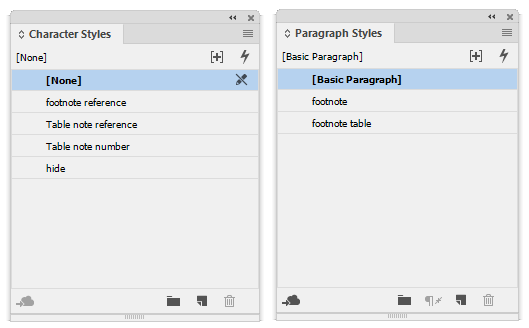Table footnotes
Table footnotes were introduced in InDesign CC2019. They work just like the footnotes that we've known for many years. Unfortunately, InDesign does them the way MS Word places table footnotes: they are part of the body text's footnote stream. But this is in fact quite unusual: most publishers want table footnotes to be grouped under the table, to start renumbering at every table, and to use a different numbering style – Roman numbers, usually, as opposed to the Arabic numbers used in the main text.
In InDesign Magazine issue #95 I described a way to do table footnotes in earlier versions of InDesign. That method is still valid and works fine, but when your starting point is a CC2019 (or later) document with footnotes in tables (imported, for instance, from Word), then the script described here is more convenient.
The script has two modes. Inline tables are placed in an inline frame, which creates a new story with the footnotes immediately following the table. The numbers are then changed to letters. The second mode covers tables in floats – that is, tables that are already in their own frames. In this case the script only changes the numbers.
The script
Here's an example of a table with footnotes the way InDesign deals with them by default:

There are two footnotes in the main text (footnotes 1 and 5), one before and one after the table. The table has three footnotes. As you can see, the footnotes are part of the document's main footnote stream.
To place the footnotes immediately after the table, click somewhere in the table and run the script. The result is this:

The script created a text frame, moved the table into it, and placed the frame as an inline anchored frame. The notes are still real InDesign footnotes: place the cursor in one of the notes and go to Type > Go to footnote reference: the cursor moves to the reference.
Using symbols to number notes
To use symbols rather than letters for the note numbers and references, edit the script as follows. Open the script in a plain-text editor and go to line 28. This reads
//var symbols = '*†‡§¶';
Remove the two forward slashes, then save the script file. The symbol set in the script (shown here) is InDesign's symbol set. You could change that if you want to any symbol set of your choice.
Adding and removing notes
To add a note, simply create a new footnote in the usual way and run the script again. The same goes for removing a note: delete it and run the script again to update the numbering.
How it works
InDesign's footnotes start renumbering at every story, which is good because it's not possible to set a starting number per story. Unfortunately, however, InDesign's footnote numbering style is a document-wide setting, so we if we want to use a different numbering style in table footnotes, we have to do the numbering ourselves. And that's what the script does.
You can see how it works when, after the conversion, you open the Character Styles panel. The script added a few character styles (see below for details), one of which is hide. Edit the style: reset it to its base and add a colour so that it's easy to see what it was applied to:

Exposing the hide style's content shows that the footnote references and numbers are hidden by the hiding style, and that the script added the Roman numbers.
Styles created by the script
In order to get everything to work, the script creates a few styles:

The paragraph style footnote and the character style footnote reference were present, they are used for styling the notes and their references.
footnote table The paragraph style used for the table notes. It's based on the default footnote style (here, footnote). Make any changes to this style to change the appearance of footnotes in tables.
Table note number The character style used for the note numbers. In Roman-numbered table footnotes, the note references and numbers usually have the same appearance, but the script uses two styles because there may be differences. If, for example, you want to add some space between the note number and the note text, add some tracking to the note number.
Table note reference The character style used for the footnote references in the table (the Roman numbers). It's based on the default footnote reference style, and adds italic. Edit the style as necessary.
hide The style that hides InDesign's note references and numbers in the table.
Note that if you want to delete a footnote, you should remove both InDesign's footnote marker (which is in the hidden style) and Roman number added by the script.
Version history
13 Dec. 2024: The script now also deals with tables in floats.
6 Jan. 2019: Added symbols as a numbering style. See 'Using symbols to number notes', above.
November 2018: First posted.
Click to show script -- to download, right click, then Save Link/Target As
Installing and running scripts
Questions, comments? Get in touch